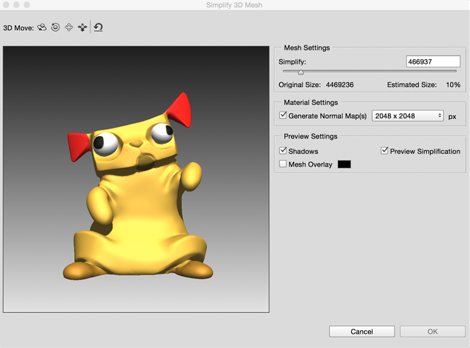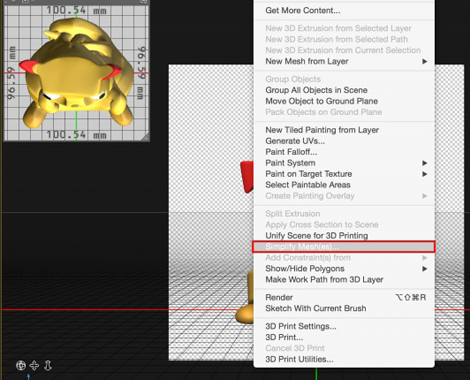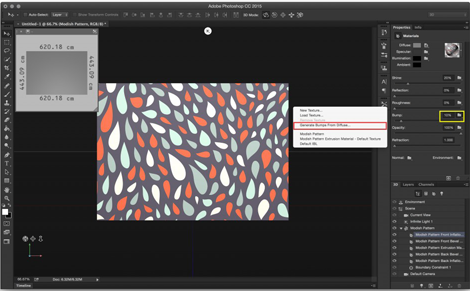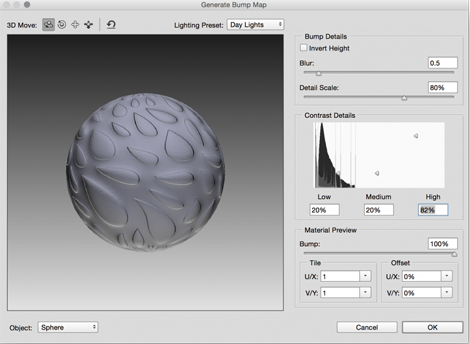
Adobe Photoshop has some exciting new 3D tools, including this mesh polygon reducer
Adobe has been making strides into the 3D printing software market, adding some brilliant features to the 3D tools in Photoshop that are continuing to advance at speed.
Speaking with Richard Curtis, Adobe’s digital imaging and 3D printing specialist, it is clear that the company is aiming to get more of its thousands of creative users to look and use 3D printing in their work.
“Our goal on the Photoshop 3D team is to make 3D design accessible to mainstream designers and artists,” said Curtis. “With this in mind, we continue to deepen and extend the 3D capabilities in Photoshop CC to make working with 3D objects faster and easier, as well as enable Photoshop to add value to a broader range of 3D workflows.”

Tools are designed to be easy to use and find within Photoshop’s main toolbar, under the 3D title
A key move is reducing the amount of polygons it takes to make up a 3D model’s mesh. Many consist of hundreds of thousands, if not millions of polygons, and though this complexity can provide the resolution detail required for many use cases, for 3D printing on a low resolution desktop 3D printer it is simply just slowing down the user’s process time, and previewing of renders.
A simple workflow using the Photoshop UI which is familiar to many, simply clicking the ‘Simplify Mesh’ command from the 3D menu will reduce the number of polygon count by a denoted percentage, and also generate normal maps (for faux geometry).
Photoshop also has the ability to automatically create a bump or normal map from an image directly within Photoshop, either from a photograph that the user has imported, or even from Adobe Stock, the company’s new stock images service that can be added on to the Creative Cloud license.

Bumpmaps can be generated from your own 2D images or textures
Users can now automatically generate and customise a detailed bump or normal map based on the colors and contrasts in the image. In addition, once the bump map is applied to a model, you can further control the desired effect on the surface of the printed model by adjusting the height and depth of the emboss/deboss at print time.
It’s a nifty process, and one which should allow for more on the fly customisation of products by end users, perhaps after a base 3D model has been produced by a designer and made available.

This textured bump map, which can be added to a 3D model within Photoshop, was created from the pattern of the previous image
Many 3D models, particularly those that have been captured using a 3D scanner, often include vertex-based color. In this release of Photoshop users will be able to convert vertex color on a 3D model to a texture, after which you could invoke the full power of Photoshop to modify and personalise the texture.
Adobe is also aiming to simplify the 3D printing pipeline, utilising its 3D PDF that appeared last year. In the 2015 release, users can send models to ‘print’ to 3D PDF.
“This means your model will be run through the 3D printing pipeline, which checks the model for printability and makes any necessary corrections before the 3D PDF file is created,” explains Curtis. “The resulting file will be ready-to-print, meaning 3D PDF can now be used more efficiently for print job submissions.”
A similar print pipeline has also been added for the new SVX data format.
Elsewhere Adobe has been busy collaborating with 3D printer companies, including 3D Hubs, with a view to allow more access to smaller desktop printers
“We have collaborated with the folks at 3D Hubs to create a suite of printer profiles for the 3D Hubs service that will allow users to print directly to service providers on the 3D Hubs network directly from within Photoshop CC,” states Curtis. “This integration brings the power of locally-based printers to every Photoshop user. The 3D Hubs profiles are shipped with Photoshop CC 2015.”
It is another big step for Adobe, which has added some truly useful tools for the 3D printing world to what is its standard Photoshop product, and we expect that there’s much more still to come.
For more information on the tools, and some great advice on how to use them, check out Richard Curtis’ blog, here.






